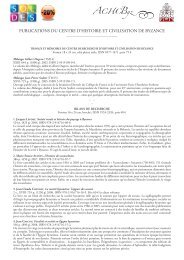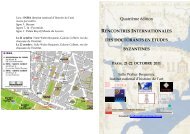booklet of abstracts - Oxford University Byzantine Society
booklet of abstracts - Oxford University Byzantine Society
booklet of abstracts - Oxford University Byzantine Society
You also want an ePaper? Increase the reach of your titles
YUMPU automatically turns print PDFs into web optimized ePapers that Google loves.
Session twelve4:15 | Saturday 5 March 2011 | Rees Davies RoomChairSean Leatherburycorpus christi CollegeSigns in the shape <strong>of</strong> Greek letterson frescos in Roman catacombs:comments on interpretations <strong>of</strong>so-called ‘gammadia’Maciej SzymaszekPontifical <strong>University</strong> <strong>of</strong> John Paul II, KrakowThe term gammadia refers to characteristicmarkings in Christian art <strong>of</strong> the first millenniumwhich appear on the mantles <strong>of</strong> figuresdepicted in catacomb paintings, mosaics,pages <strong>of</strong> illuminated manuscripts and on goldglass. Previous studies have interpreted thesesymbols as Greek letters which have particularnumerical values and thus have viewed gammadiaas a category <strong>of</strong> symbols contemporaryto each period, conveying meanings knownto everyone. This paper <strong>of</strong>fers a new look atthe problem and focuses on the earliest worksdecorated by gammadia, created in Romearound the time <strong>of</strong> Constantine the Great.This paper will perform iconographicand statistical analyses <strong>of</strong> catacomb frescosin which these symbols appear for the firsttime. These analyses will help determine thefrequency <strong>of</strong> gammadia, their patterns in variousrepresentations as well as the evolution <strong>of</strong>the shapes <strong>of</strong> particular signs, which are thefirst components <strong>of</strong> wider research regardingthe problem <strong>of</strong> gammadia in relation to historicalsources and surviving textiles from LateAntiquity. Cataloguing the catacomb frecoes inRome which feature gammadia is fundamentalfor the analysis <strong>of</strong> the other examples scatteredacross the <strong>Byzantine</strong> Empire, from Greece,Italy and Croatia to Cyprus and Egypt.Maciej Szymaszek is a second-yearMA student working on a thesis entitledSigns in the shape <strong>of</strong> Greek letters on frescosin Roman catacombs. He is interested in thematerial culture <strong>of</strong> the Mediterranean fromLate Antiquity until the end <strong>of</strong> Iconoclasm,Syriac Christianity, art and architecture <strong>of</strong>the region <strong>of</strong> Tur ‘Abdin and Gertrude Bell’sresearch in the Middle East.The wreathed cross orstephano staurion on sixthcenturymarble chancel screensin the Mediterranean regionBernard MulhollandQueens <strong>University</strong>, BelfastWhile excavating at the monastery <strong>of</strong>Beth-Shan, Fitzgerald noted that ‘betweenthese stones and the apse, we found abroken slab <strong>of</strong> marble [...] with a cross surroundedby a wreath carved on one side [...].This suggested a clue to the meaning <strong>of</strong> theword στεφανοσταυρίον (wreathed cross)which is found in both the inscriptions inthe chapel floor.’ There are examples <strong>of</strong> thewreathed cross or stephanostaurion foundon sixth-century marble chancel screensthroughout the Mediterranean region, andin many cases they are flanked by a pair <strong>of</strong>Latin crosses.These stephanostauria exhibit some variationsin composition. For example, thefour-armed cross within the wreath canbe replaced by a six- or eight-armed cross.There are also instances where the four arms<strong>of</strong> the cross are replaced by fleurs-de-lis, orwhere fleurs-de-lis are interspersed amongthe four arms <strong>of</strong> the cross. Some piercedchancel screens have intricately interlinkedThe 2011 International Graduate Conference | 33





